Red maple
(Acer rubrum var. rubrum)
Conservation • Wetland • Description • Habitat • Ecology • Use • Distribution • Taxonomy
Conservation Status |
|||
| IUCN Red List | not listed |
||
| NatureServe | N5 - Secure SNR - Unranked |
||
| Minnesota | not listed |
||
Wetland Indicator Status |
|||
| Great Plains | FAC - Facultative |
||
| Midwest | FAC - Facultative |
||
| Northcentral & Northeast | FAC - Facultative |
||
Description
Red Maple is a moderately fast-growing, moderately long-lived, medium to large, deciduous tree rising on a single trunk from shallow, horizontal roots. In Minnesota mature trees are usually 40′ to 70′ tall and up to 24″ in diameter, though large individuals can reach over 80′ in height. They typically live 100 years, rarely more than 150 years.
In the forest the trunk is usually unbranched for half its length and the crown is narrow and short. In the open the trunk usually divides near the ground into a few widely ascending branches and the crown is dense and long.
The branches are opposite, widely spreading, and ascending.
The bark on young trees is silvery gray and smooth with random, vertical cracks. If it is bruised or scraped it emits no odor. On mature trees the bark is gray to dark grayish-brown. It is separated into multiple layers of vertical, plate-like strips with scaly ridges. The strips are attached in the middle but loose and sometimes curling at the top and bottom.
The twigs are slender, shiny, bright red to reddish-brown, and hairless. When crushed they do not emit a rank odor. The sap of a freshly cut twig is clear. Opposite twigs appear in a V-shape on the branches. Younger twigs have obvious, small, white, pore-like openings (lenticels). At the end of the twig is a smooth, shiny, reddish, ⅛″ to ¼″ long, blunt, terminal bud. It is composed of 2 to 5 pairs, but usually 4 pairs, of overlapping scales.
The buds are dark brown, egg-shaped to elliptic, ¼″ long, and blunt at the tip. They are composed of 6 to 10 dark red overlapping scales. The terminal bud is red and relatively short. The leaf scar is have V-shaped and has 3 dots (bundle scars).
The leaves are opposite, stalked, 2½″ to 4″ long, and nearly as wide. The leaf stalks are red or at least show some red. There are no prominent stipules at the base of the leaf stalk. The blades are palmately lobed with usually 3, sometimes 5, lobes. The lobes taper to sharply-pointed tips. The space between the lobes (sinus) sharply V-shaped. The two bottom lobes, if present, are much smaller than the two lateral lobes. The lateral lobes are cut ¼ to ½ of the way to the base. The central lobe is more or less parallel-sided below the middle, widest at or just above the base, then tapered to the tip. The sinus at the base of the leaves is open and the two bottom lobes do not overlap. The upper surface is light green and hairless. The lower surface of young leaves is paler green and hairless or sparsely hairy. The lower surface of mature leaves is often strongly whitened, glaucous, and hairless or sparsely hairy along the main veins. The margins are irregularly toothed, including inside the sinuses, sometimes appearing double-toothed. The teeth are small. The sides and tip of the leaf do not droop. In the fall the leaves turn scarlet red, orange, or yellow. Fallen leaves break down quickly.
The inflorescence is a short, dense cluster of flowers from lateral buds on the branches. Male and female flowers are borne on the same tree and but on different branches. They appear identical, having both stamens and pistils, but usually only one of the organs is functional. They are produced in late March to May, long before the leaves appear. The flowers are pollinated by wind and bees.
The fruit is a pair of dry seed cases with papery wings attached (double samara). They occur in clusters that droop downward from long stalks. The stalks are longer than the wings. Each double samara is more or less in the shape of an inverted U, connected at the top with the wings spreading apart at about a 60° angle. The sometimes appear parallel or almost parallel. Individual samaras (or keys) are ¾″ to 1½″ long and hairless. They are slightly connected to each other when young and separated at maturity. The seed cases are plump. The wings are typically ½″ to 1″ long. The keys are green initially, turning red as they age, then tan when they are mature. They mature from April to June before leaf development is complete. They fall during a 1 to 2 week period from April to July. Paired keys are shed individually. Usually only one seed case contains a single, viable seed, although sometimes both contain seeds, sometimes both are empty.
Height
40′ to 70′
Record
The champion red maple in Minnesota is on state property near Kerrick, in Pine County. In 2009 it was measured at 80′ tall and 95″ in circumference (30″ in diameter), with a crown spread of 50′.
Flower Color
Red
Similar Species
Mountain maple (Acer spicatum) is usually a tall shrub, sometimes a small tree. The terminal lobe of the leaf is less than half the length of the entire blade, and is tapered along the sides all the way to the crotch. The inflorescence is an erect, 1½″ to 3″ long spike.
Habitat
Wet to dry. Swamps, upland woods.
Ecology
Flowering
March to May
Toxicity
The leaves of red maple are extremely toxic to horses.
Pests and Diseases
Ocellate gall midge (Acericecis ocellaris) causes a flat, purple-ringed, yellow “eyespot” gall on the upper leaf surface.
Septoria Leaf Spot (Septoria aceris) produces dark brown or tan spots with light brown centers on the upper leaf surface.
Tar Spot (Rhytisma americanum) forms few large black spots on maple leaves.
Use
Distribution |
||
|
Sources 2, 3, 5, 7, 8, 24, 28, 29, 30. Biodiversity occurrence data published by: Minnesota Biodiversity Atlas (accessed through the Minnesota Biodiversity Atlas Portal, bellatlas.umn.edu, 11/13/2025). |
|
| 11/13/2025 | ||
Nativity |
||
Native |
||
Occurrence |
||
Common |
||
Taxonomy
Kingdom
Division
Tracheophyta (Vascular Plants)
Subdivision
Spermatophytina (Seed Plants)
Class
Order
Sapindales (soapberries, cashews, mahoganies, and allies)
Family
Sapindaceae (soapberry)
Subfamily
Hippocastanoideae
Tribe
Acereae
Genus
Acer (maples)
Section
Rubra
Species
Acer rubrum (red maple)
Subordinate Taxa
Synonyms
Acer coccineum
Acer drummondii
Acer fulgens
Acer glaucum
Acer hypoleucum
Acer leucophyllum
Acer microphyllum
Acer rubrum ssp. microphyllum
Acer rubrum ssp. normale
Acer rubrum ssp. semiorbiculatum
Acer rubrum ssp. tomentosum
Acer rubrum var. clausum
Acer rubrum var. coccineum
Acer rubrum var. columnare
Acer rubrum var. eurubrum
Acer rubrum var. glabrum
Acer rubrum var. globosum
Acer rubrum var. intermedium
Acer rubrum var. latifolium
Acer rubrum var. pallidiflorum
Acer rubrum var. pallidum
Acer rubrum var. pendulum
Acer rubrum var. rubrocarpum
Acer rubrum var. sanguineum
Acer rubrum var. schlesingeri
Acer rubrum var. stenocarpum
Acer rubrum var. tomentosum
Acer rubrum var. virginianum
Acer rubrum var. viride
Acer sanguineum
Acer semiorbiculatum
Acer splendens
Acer stenocarpum
Acer tomentosum
Acer wagneri
Rufacer rubrum
Common Names
Carolina red maple
Drummond red maple
eastern red maple
maple
red maple
scarlet maple
soft maple
swamp maple
water maple
Glossary
Bundle scar
Tiny raised area within a leaf scar, formed from the broken end of a vascular bundle.
Glaucous
Pale green or bluish gray due to a whitish, powdery or waxy film, as on a plum or a grape.
Lenticel
A corky, round or stripe-like, usually raised, pore-like opening in bark that allows for gas exchange.
Palmate
Similar to a hand. Having more than three lobes or leaflets that radiate from a single point at the base of the leaf.
Samara
A dry fruit consisting of a seed attached to a papery wing; one seeded in Elms and Ashes, two-seeded in Maples.
Sinus
A space, indentation, or cleft, usually on a leaf, between two lobes or teeth.
Stipule
A small, leaf-like, scale-like, glandular, or rarely spiny appendage found at the base of a leaf stalk, usually occurring in pairs and usually dropping soon.
Visitor Photos
Share your photo of this plant.
This button not working for you?
Simply email us at info@MinnesotaSeasons.com.
Attach one or more photos and, if you like, a caption.
Bobbi Johnson |
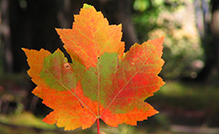 |
MinnesotaSeasons.com Photos
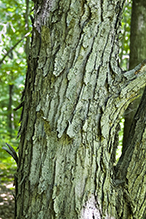 |
||
Bark |
|
|
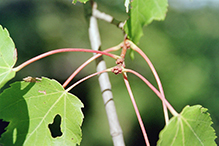 |
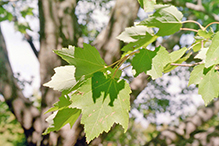 |
|
Buds |
Leaves |
|
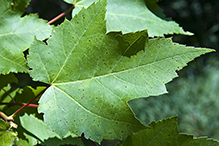 |
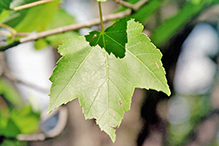 |
|
Leaves |
Leaves |

Slideshows
Acer rubrum
Blake C. Willson
Red Maple #1
villhauere
Red Maple
J.Steinbock
Acer rubrum - Red Maple
Virens (Latin for greening)
Plant portrait - Red maple (Acer rubrum)
Identify that Plant

Visitor Videos
Share your video of this plant.
This button not working for you?
Simply email us at info@MinnesotaSeasons.com.
Attach a video, a YouTube link, or a cloud storage link.
Other Videos
Trees with Don Leopold - red maple
ESFTV

Visitor Sightings
Report a sighting of this Plant.
This button not working for you?
Simply email us at info@MinnesotaSeasons.com.
Be sure to include a location.


